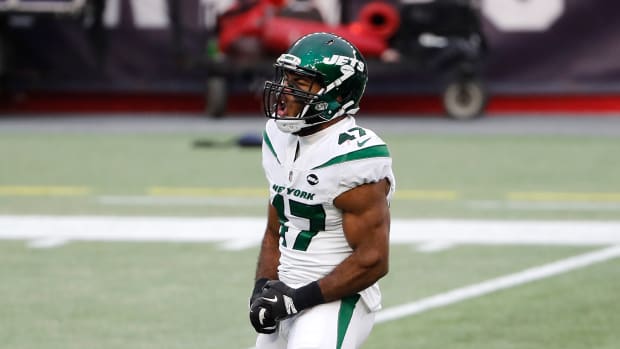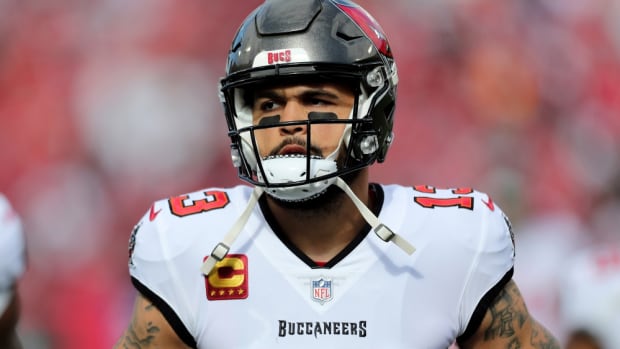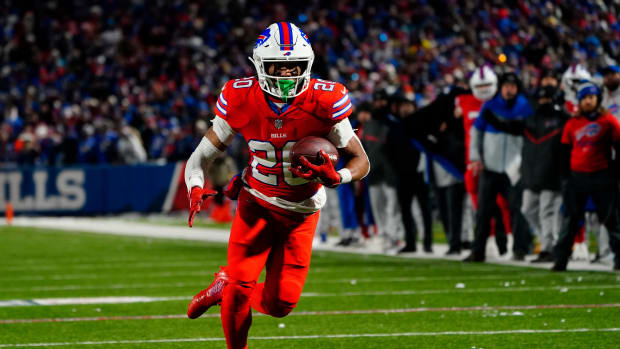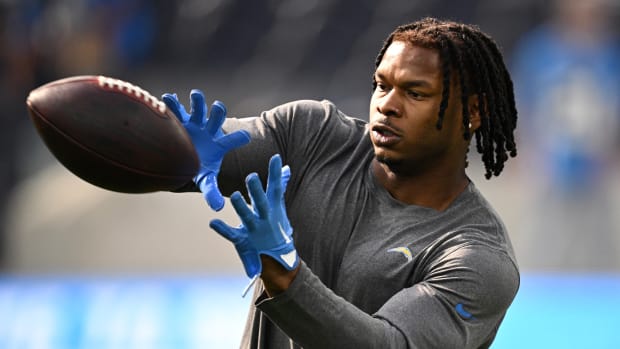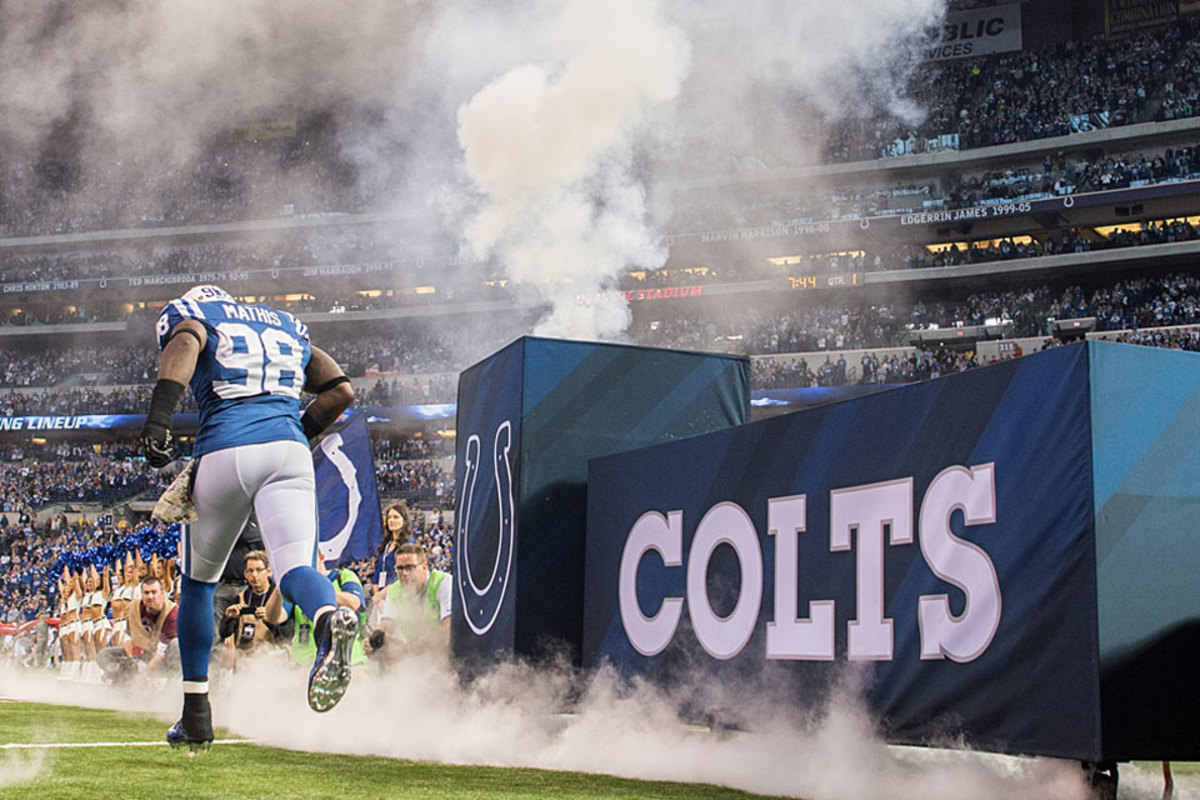
Robert Mathis: On His Own, With Plenty Behind Him
After taking down Texans quarterback Case Keenum in the endzone to set new Colts franchise records for sacks in a season and in a career, Robert Mathis paused for a moment, maybe to savor his accomplishment, maybe to enjoy what would be the final two points in a 25-3 victory on Dec. 15. The Indianapolis outside linebacker rose to one knee and saw Duane Brown, Houston’s Pro Bowl tackle whom he’d just beaten, cradling the ball in the end zone for a safety. Then Mathis playfully did three body rolls over his left shoulder.
The acrobatics caught the sellout crowd in Lucas Oil Stadium off guard, so out of character it was for the 11-year veteran. Back in his hometown of Atlanta, though, family members smiled and shook their heads. It was nothing they hadn’t seen before. Just Robert being Robert.
He was always running and jumping and tumbling as a youngster, sometimes to his detriment. When he was 5 he channeled his inner gymnast and climbed on a bed to do a backflip. With the mattress creaking beneath his weight, he jumped in place to generate momentum and took off. But instead of landing on his feet he landed in the emergency room after coming down on his head and spraining his neck.
A meeting with an old teammate earlier this year. (Andrew Hancock for SI)
It was another reminder to his five older siblings that while they could protect the baby of the bunch from the outside world, they couldn’t protect him from himself. Robert was too fearless, too competitive. Dare him to jump off a roof and he’d go airborne. Tell him he couldn’t scale a towering oak and he’d begin climbing. Challenge him to do a backflip off a bed or a washer and he’d go heels over head.
“If the people in the emergency room didn’t know my name, they definitely knew my face because I was in there, like, every other week,” he says. “I was one of those kids.”
* * *
Thought to be just a camp body coming out of Alabama A&M, Mathis has stuck for 11 years. (TMB/Icon SMI)
Decades later, the 32-year-old continues to be driven by challenges. In an NFL whose public face is increasingly framed by peach fuzz, he’s a graybeard who this season became only the second player in the last 15 years to lead the league in sacks at age 30 or older, joining former Giants end Michael Strahan, who did it at 30 and 32. He’s been a big key to Indy’s second straight 11-5 season and trip to the playoffs. They host the Chiefs on Saturday.
“That’s pretty damn impressive,” says Falcons general manager Thomas Dimitroff. “Normally at that age you start to drop of, but he’s not only elongated his peak, he’s raised his ceiling. He continues to have an impact on quarterbacks and games, and you just don’t see that very often.”
Mathis finished the regular season with 19.5 sacks, more than his previous high, set in 2005 and matched in ’08, and 3.5 more than the team record Dwight Freeney set in 2004. He also holds franchise records for career sacks (111), games with at least one sack (85) and games with multiple sacks (27), and his 44 career sack-fumbles are a league best. He five games this year with two sacks, and one with three.
But what’s truly astounding is that he achieved each of the feats in a season in which he lost his celebrated rushing mate and was moved to a new position. For Mathis the changes were “fuel to my fire,” challenges to be overcome.
He and Freeney were the league’s most productive pass-rushing tandem from 2003 to ’12, combining for 186 sacks, 73 forced fumbles and 12 Pro Bowl berths. They were the first pair of ends from the modern era to go to three consecutive Pro Bowls together, and in 2010 they recorded their fourth season of at least 10 sacks each, surpassing the league mark previously held by Philadelphia’s Reggie White and Clyde Simmons.
They could look at each other from opposite ends of the line—Mathis on the left, Freeney on the right—and know exactly what the other would do in passing situations, then they’d drop into three-point stances and race each other to the quarterback. In 147 games together Freeney got there for 94.5 sacks, Mathis for 91.5.
Their decade-long partnership ended last offseason, when Colts second-year general manager Ryan Grigson did not offer Freeney a new contract as a free agent. Freeney was 33 and coming off the second-worst season of his career, with only five sacks in 14 games while playing through a high-ankle sprain and making the transition from end to linebacker. Freeney signed as a free agent with San Diego, and Mathis was suddenly on his own. He found it awkward yet invigorating, missing his “brother” but also determined to show people he could succeed on his own.
Much of his career to that point had been spent in the considerable shadow of Freeney, the celebrated first-round pick out of Syracuse with the vicious spin move, low center of gravity, ox-like strength, and 11 or more sacks in each of his first four NFL seasons. Mathis was a fifth-round choice from tiny Alabama A&M, a 235-pound defensive end who was expected to be nothing more than a camp body.
Mathis (98) and Dwight Freeney (93) formed one of the most productive pass-rush tandem in history. (AJ Mast/AP)
Mathis didn’t know what the term “camp body” meant when he first heard it, so he asked around. When he learned it was the label used for players signed to spell veterans during training camp before being released, he seethed. Mathis won a roster spot and had 3.5 sacks in spot duty as a rookie. But even after he recording 10.5 sacks in his second season and 11.5 in his third, people said it was because opponents paying so much attention to Freeney.
“People said I wouldn’t be the same player because I was a beneficiary of Brother Freeney,” Mathis says. “I have to admit it got to me. People told me to ignore it and play my game. Well, that’s part of my game—fuel to my fire. I took all those he’s nots, he won’ts and he can’ts and turned them into I am, I will and I shall.”
He did it while playing a new position for the second time in as many seasons. His first nine years were spent as a down lineman in a four-linemen, three-linebacker scheme in which he lined up in a three-point stance and never dropped in pass coverage. But when the Colts switched to a 3-4 scheme—three linemen, four linebackers—last season, Mathis was moved to strongside linebacker. It was a significant change because the sight lines, blocking angles, footwork and hand placements were new to him—tantamount to a right-handed person being asked to write with his left, or a master of the two-step being asked to do the salsa. Oh, he also had to learn pass coverages and how to play in space.
Given the freedom to line up left, right, inside or outside in his new role, Mathis flourished, with a career-high and league-best 19.5 sacks. (Zach Bollinger/Icon SMI - 2)
“It was a culture shock for him,” says Colts defensive coordinator Greg Manusky.
And just when he got comfortable, with eight sacks, nine tackles for loss and one forced fumble in 2012, the team moved him again, this time to the “rush” linebacker spot vacated by Freeney. Unsure of what to expect, he phoned Baltimore standout Terrell Suggs, the 3-4 rush ’backer who entered the league with him in 2003.
“What’s the position all about?” Mathis asked.
“You’re going to love it!” Suggs responded. “It fits what you do. It allows you to be a playmaker.”
That meant capitalizing on his quickness, athleticism, strength and football acumen. He could line up on the left or the right, in an upright or down position, on the inside or the outside. He also could avoid some of the pass-coverage responsibilities he previously had against tight ends and running backs. His new job was as simple as the position’s name: rush the quarterback. That’s what he did on roughly 95 percent of passing situations this year.
“You know if you’re facing him it’s going to be a long day,” says Cardinals left tackle Eric Winston, who competed against Mathis twice a year while with Houston from 2006 to ’11 and was beaten for a sack-forced fumble by Mathis on Nov. 24 of this year. “He’s like preparing for a knuckleball—you never know what you’ll get. He can beat you with quickness, he can beat you with a spin move, and he can beat you with a bull rush. You just know there are going to be times when you have to find a way to survive, because you’re not going to block him clean. A lot of times you’re not even going to get your hands on him clean. You have to force him in one direction and hope for the best, because if you give him a two-way go he’ll eat you up.”
* * *
Mathis had two sacks of Chad Henne in the season finale—a warmup for the Chiefs’ visit? (Zach Bolinger/Icon SMI)
Everything Mathis does on the field is rooted in a work ethic he learned from watching his mother. Emma Mathis used to leave the house each day at 6 a.m. to work multiple jobs. She was a single parent with six kids to raise, so there was no time for complaining or complacency. Working was in her blood for as long as she could remember. As a child growing up in Barnesville, Ga., she would join family members in the cotton fields to earn money.
Robert would watch her leave the house each morning and ask, “Why are you doing this?” He couldn’t understand. “She just had to do what she had to do, to make way for us,” he says. “The older I got, the more it hit me that it’s greater than yourself. I have kids now, so I understand. I get it. There’s nothing I won’t do for them to make sure that they’re alright, and that’s because she was my role model.”
Mathis likes to say that his mother is a pipeline to his heart, which skipped a beat in May when he learned she that was diagnosed with cancer of the esophagus. As the youngest of her children, Robert was considered a mama’s boy. He could always be found at Emma’s side when he wasn't running around or in church, where he sang in the choir. One of the most fulfilling aspects of being a pro football player was enabling his mother to retire in 2006.
“She tried to instill her work ethic in all of us, but it manifest itself more in Robert,” says his sister, Lorene. “He was more adamant about doing and obeying and respecting Mama’s every wish. That’s his blessing, his gift—just being humble.”
Robert and family celebrated an AFC championship game win in January 2010; they’d welcome a trip to New Jersey this year. (David Bergman/SI)
Emma Mathis, 69, had surgery to remove the cancer in September and is doing well all things considered. Normally she attends at least five Colts home games a season, but not this year. Her condition forced her to watch Robert’s record-setting performance on television, where she saw in him the same qualities he saw in her growing up—consistency, relentlessness and an unwillingness to fail.
On that sack, Mathis looked adequately blocked as Brown rode him to the outside of the pocket and pushed him past the spot where Keenum should have been. But Keenum, an undrafted rookie who could be rattled, held the ball too long and began to drift back in the pocket. That gave Mathis a chance to bend to the inside, where he pounced on Keenum from behind, knocking the ball loose in the end zone.
“That goes back to being a good athlete,” says Winston, who saw the replay. “When I say that, I don’t mean 40-yard times. I mean the way he bends, the way he can turn, the way he dips and contorts his body. Most people would lose their balance and fall, but he can plant his feet and get around the edge and slap the ball. He’s just tough, tough to block.”
As he kneeled and watched the official signal safety, an array of thoughts ran through his mind—how some people believed he was small to make it as an NFL end; how some said he was too slow to play linebacker after running a 4.5-second 40; how some said he’d be less effective without Freeney; how his wife and twin boys were watching from the stadium; how his mother and siblings were watching from Atlanta. Then he smiled broadly and performed his acrobatics. He didn’t end up in the emergency room, though—he’s come too far for that.







































